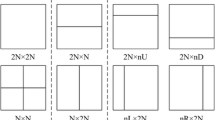Abstract
In this paper, the feasibility and efficiency of non-causal prediction for P-frames is examined, and based on the findings, a new P-frame coding scheme is proposed. Motion-compensated inter-frame prediction, which has been used widely in low-bit-rate television coding, is an efficient method for reducing temporal redundancy in a sequence of video signals. To this end, the proposed scheme combines motion compensation with non-causal prediction based on an interpolative, but not Markov, representation. Nevertheless, energy dispersion occurs in the scheme as a result of the interpolative prediction transform matrix being non-orthogonal. To solve this problem, we have introduced a new conditional pel replenishment method. On the other hand, we have applied rotation scanning, which is also applied for feedback quantization, as a quantizer. Simulation results show that the proposed coding scheme achieves an approximate 44 dB when entropy is less than 1 bit/pixel.













Similar content being viewed by others
References
Netravali, A. N., & Rabbins, J. D. (1979). Motion compensated television coding: part І. Bell System Technical Journal, 58(3), 631–670.
Jayant, N. S., & Noll, P. (1984). Digital coding of waveforms. Englewood Cliffs: Prentice Hall.
Wang, C., Kubota, A., & Hatori, Y. (2010). A new hybrid parallel intra coding method based on interpolative prediction. 28th Picture Coding Symposium (PCS) (December 7–10), Nagoya, Japan, pp. 406–409.
Jain, A. K. (1975). Image coding via a nearest neighbors image model. IEEE Transactions on Communications, COM-23(3), 318–331, (Mar).
Hatori, Y. (1983). Optimal quantizing scheme in interpolative prediction. The Journal of the Institute of Electronics, Information and Communication Engineers, J66-B No.5, Tokyo.
Wang, C., & Hatori, Y. A parallel hybrid video coding method based on noncausal prediction with multimode. ISVC’11 Proceedings of the 7th international conference on Advances in visual computing – Volume Part II.
Fowler, J. E. (1998). Generalized threshold replenishment: an adaptive vector quantization algorithm for the coding of nonstationary sources. IEEE Transactions on Image Processing, 7, 1410–1424.
de Lima Filho, E. B., da Silva, E. A. B., de Carvalho, M. B., & Pinage, F. S. (2008). Universal image compression using multiscale recurrent patterns with adaptive probability model. IEEE Transactions on Image Processing, 17(4), 512–527.
Miaou, S.-G., & Yen, H.-L. (2001). Multichannel ECG compression using multichannel adaptive vector quantization. IEEE Transactions on Biomedical Engineering, 48(10), 1203–1207.
Fowler, J. E. (2000). Adaptive vector quantization for efficient zerotree-based coding of video with nonstationary statistics. IEEE Transactions on Circuits and Systems for Video Technology, 10(8), 1478–1488.
Shen, G., Zeng, B., & Liou, M.-L. (2003). Adaptive vector quantization with codebook updating based on locality and history. IEEE Transactions on Image Processing, 12(3), 283–295.
Wallace, G. K. (1991). The JPEG still picture compression standard. Communications of the ACM, 34(4), 31–44.
Le Gall, D. (1991). MPEG: a video compression standard for multimedia applications. Communications of the ACM, 34(4), 47–58.
Liou, M. (1991). Overview of the px64 kbps video coding standard. Communications of the ACM, 34(4), 60–63.
Ahmed, N., Natarajan, T., & Rao, K. R. (1974). Discrete cosine transform. IEEE Transactions on Communications, COM-23, 90–93.
Antonini, M., Barlaud, M., Mathieu, P., & Daubechies, I. (1992). Image coding using wavelet trans-form. IEEE Transactions on Image Processing, 1(2), 205–221.
Li, Z.-N., & Drew, M. S. (2004). Fundamentals of multimedia. New Delhi: Pearson Education.
Mori, S., Kubota, A., & Hatori, Y. (2010). Examination of hybrid coding method by interpolative prediction and DCT quantization. IEVC 2010, 2C-3, Nice, France, (Mar).
Shannon, C. E. (1948). a mathematical theory of communication. Bell System Technical Journal, 27, 623–656.
Jack, K. (2001). Video demystified. Mumbai: Penram International Publishing Pvt. Ltd.
Pratt, W. K. (1970).Karhumen-Loeve transform coding of images. Presented at the 1970 I.E. Int. Symp. Information Theory, June.
Pratt, W. K., Kane, J., & Andrews, H. C. (1969). Hadamard transform image coding. Proceedings of the IEEE, 57, 58–68.
Akihiko, M., & Tanaka, M. (1986). Image data compression method based on interpolative DPCM by area decomposition. IEICE Transactions, J69-D(3), 375–382.
Akihiko, M. (1992). An analysis and a reduction method of coding error in interpolative DPCM. IEICE Transactions, J75-D-II(9), 1565–1572.
Fujita, T., Kubota, A., & Hatori, Y. (2009). Adaptive quantization ordering in feedback quantization for interpolative prediction coding. ITE Journal, 63(11), 1652–1658.
Sehgal, A., Jagmohan, A., & Ahuja, N. (2004). Wyner-Ziv coding of video: an error-resilient compression framework. IEEE Transactions on Multimedia, 6(2), 249–258.
Pyun, J.-Y. (2005). Adaptive video redundancy coding for scene and channel adaptation over error-prone network. IEEE Transactions on Consumer Electronics, 51(3), 967–974.
van der Schaar-Mitrea, M., & de With, P. H. N. (2000). Hybrid compression of video with graphics in DTV communication systems. IEEE Transactions on Consumer Electronics, 46(4), 1007–1017.
H.264/14496-10 AVC reference software manual, Jan, 2009
Acknowledgments
The authors wish to thank all researchers from the Picture Coding Symposium of Japan (PCSJ). They offered us many constructive suggestions. This work has been supported in part by a grant from KAKENHI (23560436).
Author information
Authors and Affiliations
Corresponding author
Additional information
This research was supported by KAKENHI (23560436).
Appendix
Appendix

Rights and permissions
About this article
Cite this article
Wang, C., Kubota, A. & Hatori, Y. A Novel Encoding Method for P-frames. J Sign Process Syst 81, 1–10 (2015). https://doi.org/10.1007/s11265-014-0876-1
Received:
Revised:
Accepted:
Published:
Issue Date:
DOI: https://doi.org/10.1007/s11265-014-0876-1




